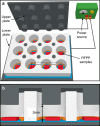Electric fields control the orientation of peptides irreversibly immobilized on radical-functionalized surfaces
- PMID: 29367659
- PMCID: PMC5783936
- DOI: 10.1038/s41467-017-02545-6
Electric fields control the orientation of peptides irreversibly immobilized on radical-functionalized surfaces
Abstract
Surface functionalization of an implantable device with bioactive molecules can overcome adverse biological responses by promoting specific local tissue integration. Bioactive peptides have advantages over larger protein molecules due to their robustness and sterilizability. Their relatively small size presents opportunities to control the peptide orientation on approach to a surface to achieve favourable presentation of bioactive motifs. Here we demonstrate control of the orientation of surface-bound peptides by tuning electric fields at the surface during immobilization. Guided by computational simulations, a peptide with a linear conformation in solution is designed. Electric fields are used to control the peptide approach towards a radical-functionalized surface. Spontaneous, irreversible immobilization is achieved when the peptide makes contact with the surface. Our findings show that control of both peptide orientation and surface concentration is achieved simply by varying the solution pH or by applying an electric field as delivered by a small battery.
Conflict of interest statement
The authors declare no competing financial interests.
Figures







Similar articles
-
Biological nano-functionalization of titanium-based biomaterial surfaces: a flexible toolbox.J R Soc Interface. 2010 Feb 6;7 Suppl 1(Suppl 1):S93-S105. doi: 10.1098/rsif.2009.0418.focus. Epub 2009 Nov 4. J R Soc Interface. 2010. PMID: 19889692 Free PMC article. Review.
-
Tuning peptide affinity for biofunctionalized surfaces.Eur J Pharm Biopharm. 2013 Sep;85(1):69-77. doi: 10.1016/j.ejpb.2013.02.006. Epub 2013 Feb 27. Eur J Pharm Biopharm. 2013. PMID: 23454053 Review.
-
Investigation of the peptide adsorption on ZrO2, TiZr, and TiO2 surfaces as a method for surface modification.ACS Appl Mater Interfaces. 2014 May 28;6(10):7408-16. doi: 10.1021/am500823m. Epub 2014 Apr 29. ACS Appl Mater Interfaces. 2014. PMID: 24735333
-
Functionalisation of Ti6Al4V and hydroxyapatite surfaces with combined peptides based on KKLPDA and EEEEEEEE peptides.Colloids Surf B Biointerfaces. 2017 Dec 1;160:154-160. doi: 10.1016/j.colsurfb.2017.09.022. Epub 2017 Sep 9. Colloids Surf B Biointerfaces. 2017. PMID: 28922634
-
Covalent immobilization of antimicrobial peptides (AMPs) onto biomaterial surfaces.Acta Biomater. 2011 Apr;7(4):1431-40. doi: 10.1016/j.actbio.2010.11.005. Epub 2010 Nov 5. Acta Biomater. 2011. PMID: 21056701 Review.
Cited by
-
Electrobiofabrication: electrically based fabrication with biologically derived materials.Biofabrication. 2019 Apr 26;11(3):032002. doi: 10.1088/1758-5090/ab06ea. Biofabrication. 2019. PMID: 30759423 Free PMC article. Review.
-
Grafting of short elastin-like peptides using an electric field.Sci Rep. 2022 Nov 4;12(1):18682. doi: 10.1038/s41598-022-21672-9. Sci Rep. 2022. PMID: 36333395 Free PMC article.
-
Surface bio-engineering of melt electrowritten tubular scaffolds via plasma immersion ion implantation (PIII).Mater Today Bio. 2025 May 29;33:101923. doi: 10.1016/j.mtbio.2025.101923. eCollection 2025 Aug. Mater Today Bio. 2025. PMID: 40585022 Free PMC article.
-
Molecular Decoration of Ceramic Supports for Highly Effective Enzyme Immobilization-Material Approach.Materials (Basel). 2021 Jan 3;14(1):201. doi: 10.3390/ma14010201. Materials (Basel). 2021. PMID: 33401646 Free PMC article.
-
It takes two for chronic wounds to heal: dispersing bacterial biofilm and modulating inflammation with dual action plasma coatings.RSC Adv. 2020 Feb 18;10(13):7368-7376. doi: 10.1039/c9ra09875e. eCollection 2020 Feb 18. RSC Adv. 2020. PMID: 35492196 Free PMC article.
References
-
- Dias, J., Kay, P., Porter, M. & Briggs, T. Restoring Your Mobility. Available at http://www.boa.ac.uk/wp-content/uploads/2014/01/BOA-Practise-Strategy.pdf (British Orthopaedic Association, 2012).
Publication types
MeSH terms
Substances
LinkOut - more resources
Full Text Sources
Other Literature Sources

